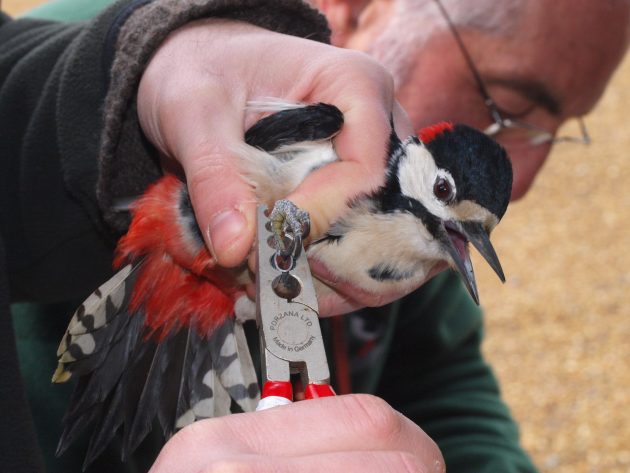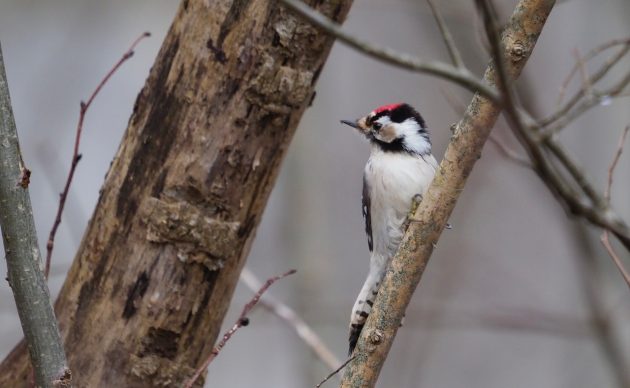One of the first birds I remember seeing was a Green Woodpecker. It had landed on our neighbours’ lawn, and I was invited round to see it. I was only five at the time, but already fascinated by birds and the proud possessor of my own copy of The Observers’ Book of Birds. According to the latter, these woodpeckers are “especially fond of ants, and will leave the trees in search of ants’ nests”; this was clearly what this woodpecker was up to.
I was reminded of this incident when, earlier this month, a juvenile Green Woodpecker landed on my lawn and proceeded to hop around, looking for ants (above). Though I occasionally hear these woodpeckers calling when I’m out in the garden, I don’t see them in my garden very often, so I was prompted to reach for my camera. You can tell that the bird is a juvenile, not long out of the nest, by its barred underside and streaked cheeks, while it has only has a hint of the crimson crown and nape it will acquire after its first moult. But though it wasn’t in full plumage, it was still a handsome bird.

An adult male Green Woodpecker. The moustache of the female is all black, while the male displays a red centre to the moustache
I may not encounter these woodpeckers in my garden very often, but they are common birds locally, and one I see every week, if not every day, throughout the year. I hear more than I see, for their loud laughing call is far-carrying: it’s the call that gives them their old country name of yaffle. If I do see one, then it’s often a going away view as the bird flies away, flashing a distinctive yellow rump.

Green Woodpeckers are doing well in England, Wales and Scotland, and their population has risen slightly (up by 8%) in recent years. They like our warming climate, as they suffer badly during prolonged periods of freezing weather: the severe winter of 1962/63 (by far the coldest of the last century) reduced the population by 50%. They aren’t found in Ireland, nor the Isle of Man.

Prolonged spells of freezing weather are bad news for Green Woodpeckers
Until recently the Green Woodpecker’s cousin, the Great Spotted, didn’t occur in Ireland either, but it started breeding there in 2005 and is now well established and widespread, breeding in every county. This woodpecker’s colonisation of Ireland isn’t really surprising, as the population in mainland Britain rose by a remarkable 403% between 1967 and 2020, and unlike the Green Woodpecker, it’s a bird that is more prepared to undertake sea crossings.

A female Great Spotted Woodpecker. The lack of red on the nape indicates her sex

Great Spotted Woodpeckers are attracted to gardens by fat
Today there are an estimated 130,000 pairs in Britain, compared with 46,000 Green Woodpeckers. These handsome black-and-white birds are frequently seen in gardens, often becoming a regular visitor to bird tables where they like peanuts and fat balls. They are surprisingly omnivorous, and though they don’t hunt ants, they consume a wide variety of foods. In spring they are a serious predator of young birds, hammering their way into tit nest boxes to take, and eat, any chicks that they can find.

Ringing a Great Spotted Woodpecker. In Britain most show little tendency to undertake long-distance movements, and recoveries are usually within 2km (a little over a mile) of the ringing site

Though it’s not proven, the increase in the number of Great Spotted Woodpeckers is thought to be partly responsible for the serious decline of our third species of woodpecker, the Lesser Spotted. This is a tiny bird – hardly any bigger than a sparrow – but is easily recognised by its woodpecker shape and its black back barred with white (it used to be called the Barred Woodpecker for this reason). It seems likely that the Great Spotted Woodpecker out competes the Lesser Spotted, as well as predating its nests.

Lesser Spotted Woodpeckers are the smallest of Europe’s woodpeckers
Lesser Spotted Woodpeckers are close to extinction in my home county of Suffolk – it’s at least eight years since I last saw one locally, while the most recent Suffolk bird report (for 2022) notes no successful reports of nesting in the county. According to the British Trust for Ornithology (BTO), the population declined by 93% during the period 1967 – 2000, but “The demographic causes of decline are not yet known and, although there is low breeding success in some populations, the reasons for the decline are unclear.”

The barred back of the Lesser Spotted is diagnostic. The red head indicates that this is a male
Populations have fallen on the Continent, too, though they remain common in many countries – it’s a bird I always expect to see when I visit northern Greece, and I enjoyed watching these delightful little birds last year in Estonia, where my accompanying photographs were taken.
Incidentally, there are 256 species of woodpeckers in the world, of which I’ve been lucky enough to have seen 86. Though they are a widespread and successful family, the greatest variety is to be found in the Americas. Here in Europe we have a mere 11 species. Until recently it was 10, but most taxonomists now regard the Green Woodpecker that occurs in Iberia (Spain and Portugal) as a distinct species, not just a race of its more widespread cousin. The scientific name of the Iberian Green Woodpecker is Picus sharpei: it is named after the British ornithologist Richard Sharpe (1847-1909), who is credited with first separating it from the Green Woodpecker. Sharpe was fascinated by classification and phylogeny, writing descriptions of over 200 species, while several birds are named after him, ranging from an extinct rail to a rosefinch.

Wrynecks are widespread breeding birds in Europe and Asia. This bird was photographed in northern India, where it was wintering
Europe’s woodpecker total includes the Wryneck, an aberrant woodpecker as it doesn’t peck wood. Wrynecks used to breed in Britain, but they stopped doing so regularly 60 years ago. These curious birds are scarce passage migrants in the British Isles, but they remain widespread on the continent, their range extending right across Asia as far east as Japan, where they breed on Hokkaido. Most winter in Africa and India, though a few remain in southern Europe during the winter months – I have seen them in Portugal, in the Algarve, in February. I’ve never been lucky enough to have seen one wintering in Africa (though I have seen the closely related and non-migratory Rufous-necked Wryneck a number of times), but I have seen them in India. The photograph above was taken at Saltnapur, a fine bird reserve not far from Delhi, in March. Few birds have such cryptic plumage as the Wryneck, so it’s a bird that is easy to overlook, but in the spring the males call loudly and persistently, making them much easier to find.
Source link

